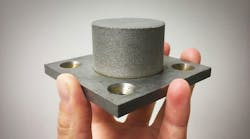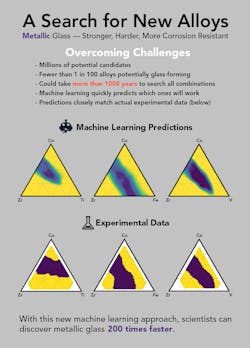Metallurgists have long sought the Holy Grail of alloys, metallic glass that is strong and won’t shatter. It is amorphous, with its atoms arranged every which way, much like the atoms of the glass in a window. Its glassy nature makes it stronger and lighter than today’s best steel, plus it stands up better to corrosion and wear.
Even though metallic glass would be useful as a protective coating or an alternative to steel, only a few thousand of the millions of possible combinations of ingredients have been evaluated over the past 50 years, and of those, only a handful developed to the point that they may become useful.
Now a group led by scientists at the Department of Energy’s SLAC National Accelerator Laboratory, the National Institute of Standards and Technology (NIST), and Northwestern University has reported a shortcut for discovering and improving metallic glass–and, by extension, other elusive materials–at a fraction of the time and cost.
The research group took advantage of an investigative approach at SLAC’s Stanford Synchrotron Radiation Lightsource (SSRL) that combines machine learning–a form of artificial intelligence in which computer algorithms glean knowledge from enormous amounts of data–with experiments that quickly make and screen hundreds of sample materials at a time. This combination led the team to discover three new blends of ingredients that form metallic glass, and to do this in 0.5% of the time it would’ve taken using traditional methods.
“It typically takes a decade or two to take a material from discovery to commercial use,” says Northwestern Professor Chris Wolverton, an early pioneer in using computation and AI to predict new materials. “This is a big step in trying to squeeze that time down. You could start out with nothing more than a list of properties you want in a material and, using AI, quickly narrow the huge field of potential materials to a few good candidates.”
The goal, he says, is to get to the point where an engineer could scan hundreds of sample materials, get almost immediate feedback from machine learning models, and have another set of samples ready to test the next day, or even within the hour.
For example, over the past half century, scientists have investigated about 6,000 combinations of ingredients that form metallic glass. The SLAC team made and screened 20,000 in a year.
Although other research teams have used machine learning to come up with predictions of metallic glass, the SLAC team is the first to rapidly verify their predictions with experimental measurements and then repeatedly cycle the results back into the next round of machine learning and experiments.
To make the process even speedier, the team plans to eventually automate it to take people out of the loop so engineers can concentrate on other aspects of their work that require intuition and creativity.
The new method will be useful in all kinds of experiments, according to the team, especially in searches for metallic glass and catalysts whose performance is strongly influenced by the way they’re manufactured, and those where scientists don’t have theories to guide their search. With machine learning, no previous understanding is needed. Algorithms make connections and draw conclusions on their own, and this can steer research in unexpected directions.
“One of the more exciting aspects of this is that we can make predictions so quickly and turn experiments around so rapidly that we can afford to investigate materials that don’t follow our normal rules of thumb about whether a material will form a glass or not,” says Jason Hattrick-Simpers, a materials research engineer at NIST. “AI is going to shift the landscape of how materials science is done, and this is the first step.”
SLAC is also working with a Silicon Valley AI company, Citrine Informatics, to transform the way new materials are discovered and make the tools for doing that available to scientists everywhere. Founded by former grad students from Northwestern and Stanford University, Citrine has created a materials science platform in which data that had been locked away in published papers, spreadsheets, and lab notebooks is stored in a consistent format so it can be analyzed with AI specifically designed for materials.
“We want to take materials and chemical data and use them effectively to design new materials and improve manufacturing,” says Greg Mulholland, founder and CEO of Citrine. “This is the power of artificial intelligence: As scientists generate more data, it learns alongside them, bringing hidden trends to the surface and letting scientists identify high-performance materials much faster and more effectively than relying on traditional, purely human-driven materials development.”
Until recently, thinking up, making, and assessing new materials was a painfully slow process. For instance, the SLAC team calculated that even if you could cook up and examine five potential types of metallic glass a day, every day of the year, it would take more than a thousand years to plow through every possible combination of metals. And even when they get lucky and discover a metallic glass, they still struggle to overcome problems that hold these materials back. Some have toxic or expensive ingredients, and all of them share glass’s brittle, shatter-prone nature.
Over the past decade, scientists at SLAC and elsewhere have developed ways to automate experiments so they can create and study more new materials in less time. Today, some researchers can get a preliminary analysis of their data almost as soon as it comes out with AI software developed by SLAC, Citrine, and the CAMERA project at DOE’s Lawrence Berkeley National Laboratory. It lets them analyze more than 2,000 samples per day.
In the metallic glass study, the research team investigated thousands of alloys that each contain three cheap, nontoxic metals. They started with a trove of materials data dating back more than 50 years, including the results of 6,000 experiments that searched for metallic glass. Based on what the algorithms learned in this first round, the team crafted two sets of sample alloys using two different methods, letting them test how manufacturing methods affect whether an alloy morphs into a glass.
Both sets of alloys were scanned by an X-ray beam, the data fed into the Citrine database, and new machine learning results generated, which were used to prepare new samples that underwent another round of scanning and machine learning.
By the experiment’s third and final round, the group’s success rate for finding metallic glass had increased from one out of 300 or 400 samples tested to one out of two or three samples tested. The metallic glass samples they identified represented three different combinations of ingredients, two of which had never been used to make metallic glass before.


